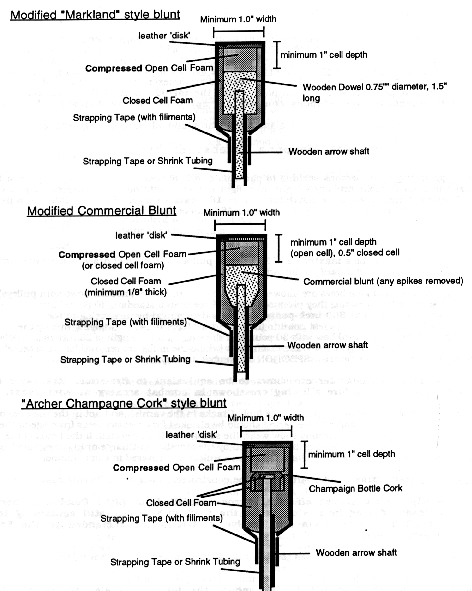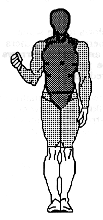
Other Projectiles are standardized javelins and hand darts, and all forms of siege engines.
Bow Types: Recurve and long bows are allowed but not compound bows (modern bows with pulleys). Crossbows are permitted providing they produce no more force than a standard 30 pound bow. The current allowable poundage is 600 inch-pounds. This is determined by measuring in the displacement of the string from its rest point to the nut (draw length) and multiplying this by the poundage of the bow. A standard bow with 30 pounds of draw and a draw length of 20 inches (28 inches - 8 inches at rest) is 600 inch-pounds. Take-down bows (where the limbs are removable) are acceptable. [see crossbow measurements under INSPECTION for combat archery.]
NOTE: Some localities consider crossbows to be equivalent to fire-arms. Make sure to check local ordinances before allowing crossbows in combat archery at your event.
Bows must be free of cracks running across the limb. Cracks in the varnish and not in the material of the bow limb itself may be exempted. The string should be checked for excessive wear from age or the use of gauntlets. If all bow string strands show wear, the string should be rejected. If the limbs of the bow show noticeable twist, the bow may be disallowed by the Marshal-in-Charge or his designated Archery Marshal. No part of a bow may have red upon it unless it is covered in some manner.
Arrows and Quarrels: Arrows and quarrels shall be constructed using the following rules:
Metal piles (tips) must be cut off of all arrows modified for Light Combat Archery. Any archer caught during inspection or on the field with arrows still containing the metal pile shall be banned from ALL combat activities and remanded to the Earl Marshal's Quarter Court.
Only wood shafted arrows may be used. Metal and fiberglass arrows are forbidden.
The maximum length of each arrow shall be 28" (not counting the blunt).
All combat arrows shall be fitted with one of the following styles of 'blunt". The "Modified 'Markland' style blunt" shall be considered preferable but blunts produced from commercially available blunts shall be considered acceptable provided they present a striking surface that is flat and at least 1.0" in diameter. Blunts that are fltted with projections (such as old Saunders Bludgeons) shall have the projects cut off flush with the top of the blunt. All blunts shall have a minimum of O.5" of closed cell foam or 1.0" of compressed open cell foam (compressed to 0.5") between the striking surface and the blunt.

The entire length of the arrow shaft from behind the blunt to the fletching, shall be either taped with fiber strapping tape in a lengthwise or spiral fashion so that the wraps overlap, or covered with industrial 'shrink tubing'. Duct tape, masking tape and electrical tape are expressly forbidden.
All blunts shall have a disk of light leather at least 1" in diameter at the striking surface (6 oz or heavier). This serves both to help prevent catastrophic punch through and to provide a more positive and consistent striking sound when hitting. It is worth noting that the addition of the leather disk will tend to make the arrow strike somewhat harder. To compensate for this do not compress the foam under the dlsk as much as you might normally.
All blunts must be secured to the arrow shaft with fiber strapping tape that passes over the top of the blunt and attaches to the arrow shaft itself. All blunts shall be colored red or international orange on the end and sides.
Arrows must have at least two fletches made from either feathers or plastic (feathers are preferred for appearance and periodicity, but plastic will hold up better)
All arrows require an identiflable and visible "owner's mark". This can be a standard cresting method provided the crest is logged by the Marshal-in-Charge, but a written name and kingdom is preferable. Any arrow not marked such that the owner can be readily identifled shall be confiscated and not returned, for this reason, more period cresting method are not recommended as the owner cannot be identified without leaving the fleld and consulting a crest register.
Archers may not carry either forearm shields or bucklers. This rule is strictly intended to help prevent archers from having their bows struck during combat. As the most likely arm to hold a shield will be the bow arm, any blow that does not strike the shield wlll Iikely contact the bow. If the archer drops his bow and arms with a normal hand weapon an additional shield may be used according to the normal rules for light weapons combat. When re-arming with the bow, the shield must be removed.
Pavises: Archers may use a pavis (a legal unmanned shield) propped up by Javelin or a piece of rattan that is beveled at both ends so that it presents no danger to the fighters if it should be detached from the pavis. A pavis may be equipped with a quiver to hold additional arrows. Free standing quivers are not acceptable as they present a hazard if fallen upon or tripped over
Arrows that strike a target squarely shall be considered the equivalent to sword blows to the same area. Arrows do not have to strike with force to be considered good hits and it is permitted for others on the fleld (marshals, friends, foes, etc.) to inform someone he/she has been hit and where. Arrows that are deflected from weapons, shields or the ground are considered to be no good. Remember, this is a touch sport so any non-deflected blow should be considered good.
Any arrow tip or hand weapon striking a bow is considered to have broken the bow for the remainder of the combat, however, light weapons flghters are cautioned that deliberately striking at a bow or hand is considered an infraction of the rules. If this is a resurrection battle, a 'destroyed' bow may be resurrected with the fighter after having been examined by a marshal for damage (assuming the scenario rules don't prohibit resurrecting as archers).
A bow may be used to sweep arrows in flight aside, however, if the bow itself is struck by the arrow head, the bow is considered destroyed.
When an archer is killed, he should place the bow over his head and exit the field.
All participants in combat may glean arrows that have been shot, however, no arrow may be re-shot until it has been removed from the field or to a designated inspection point and inspected for breakage and punch-through. Any archer shooting an arrow that has been recovered from the ground without first bringing it to a central inspection point (or directly inspecting the arrow with the aide of a marshal) shall be considered killed in that scenario and be subject to a marshal's court. Arrows may be gleaned from the quivers of dead fighters (with their permission - however, selective permission [only your own side, etc] is not acceptable) and used without additional inspection
Inspection shall consist, at a minimum, of:
1. Checking for punch through of the shaft through the blunt
2. Making sure the blunt is still well attached to the shaft
3. Examining the arrow for obvious flaws or broken tape
4. Holding the arrow by the blunt and nock and flexing it in at least 3 directions while
listening and watching for breaks.
If the arrow is suspect, treat it as broken and examine it more closely after the battle.
Archers passing out of the scenario boundaries shall be considered routed and may not re-enter the field.
If an archer is located in a tree or structure, the archer is considered killed if the tree or structure is struck with any weapon other than an arrow. While it may be realistic to have the opponent be forced to climb up after you, the safety issues overweigh the realism benefits. The minimum range for releasing an arrow at an opponent is 5 yards (l5 feet). All arrows must be shot from a bow to be effective. Arrows may not be thrown or used as thrusting weapons.
Archers shall be considered legitimate targets for light weapons fighters and shall be killed in the same manner as a light weapons fighter armed with a hand weapon. Light weapons fighters should avoid blows that might strike the bow and archers shall not attempt to parry weapon attacks with their bow. A weapon hit to an archer's quiver is not considered to have broken the arrows in the quiver.
A light weapons combat archer may carry a shinai, pole weapon or other hand weapon while shooting the bow. If the archer desires to change to this weapon, the bow must be placed on the ground or given to a marshal (it may not be stowed on the archer's back or other location on his person). Under no circumstances may an archer have a bow in one hand or on his person and a hand weapon in the other. The bow dropped is not considered broken (provided it has not been struck with a weapon, an arrow or stepped upon) and may be recovered and reused after the hand weapon is stowed.

| Caid Combat Handbook - Volume II | 8/30/95 |